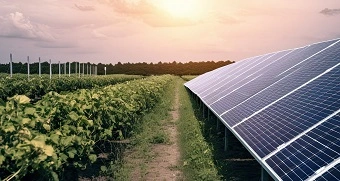Dual Harvest: Agrivoltaics and the Quest for Renewable Energy in Agriculture
29 Apr 2024 • by Natalie Aster

In the quest for sustainable solutions to meet the escalating demands for food and energy, agrivoltaics (aka agrophotovoltaics) has emerged as a revolutionary breakthrough. This modern approach integrates photovoltaic panels with agricultural practices, enabling the simultaneous production of electricity and crops. Key components of agrivoltaic systems include photovoltaic panels installed above the crops, designed to optimize light absorption and electricity generation. These systems are tailored to control the amount of sunlight reaching the plants, thereby not only generating power but also modulating microclimates that benefit plant growth. This method is gaining traction as a means to harness solar energy while not foregoing valuable agricultural production.
By enhancing clean energy production and optimizing land use, agrivoltaics holds the promise of transforming the agricultural landscape and supporting global sustainability goals.
Harnessing the Sun for Sustainable Farming
Improved Land Resource Management: One of the key advantages of agrivoltaics is the optimized use of agricultural land. Traditional solar farms often occupy vast areas that could otherwise be used for farming. Agrivoltaics eliminates this competition by allowing both activities to coexist.
Increased Agricultural Output: The shade cast by solar panels shields crops from excessive heat and sunlight, which can be detrimental during peak summer months. This microclimate can lead to higher yields for certain crops, particularly those sensitive to extreme weather conditions.
Renewable Energy Generation: By harnessing solar power, agrivoltaic systems contribute to renewable energy goals. Farms equipped with these systems can generate electricity to power their operations or sell excess energy back to the grid, creating an additional revenue stream.
Water Preservation: The shade of solar panels prevents excessive water evaporation from the soil, promoting better water retention and reducing the need for irrigation. Research has demonstrated that agrivoltaic systems can lead to a reduction in water usage by up to 20%. This benefit is especially significant in arid regions where water scarcity is a critical issue.
Climate Resilience: Agrivoltaic systems can boost the resilience of agricultural operations to climate change. By mitigating extreme weather conditions, such as heatwaves and droughts, these systems support more stable food production.
Countries Pioneering the Use of Agrivoltaics
Japan has been a leader in agrivoltaic adoption, with numerous projects showcasing the successful integration of solar panels with agricultural practices. In regions like Okayama, agrivoltaic systems have been used to grow tea, herbs, and vegetables, leading to increased yields and energy production.
In France, the Sun’Agri project has focused on the development of dynamic agrivoltaic systems that adjust panel positions based on real-time data. This approach optimizes light distribution and enhances crop growth while maximizing solar energy generation.
In the United States, pilot projects in states like California and Colorado have explored the potential of agrivoltaics in diverse agricultural settings. These initiatives have highlighted the benefits of improved land use efficiency and climate resilience.
The Road Ahead for Solar-Powered Agriculture
As the world’s population continues to grow, the need for sustainable food and energy solutions becomes increasingly urgent. Agrivoltaics represents a viable path forward, offering a dual harvest of crops and clean energy.
The potential for agrivoltaics is vast, with research continuously expanding into different crop types and climatic conditions. As technology advances, the cost of solar panels is expected to decrease, making agrivoltaics more accessible to farmers across the globe. Besides, with rising awareness of the environmental impacts of traditional farming practices and energy production, agrivoltaics stands out as a sustainable alternative that could revolutionize both industries.
By bridging the gap between agriculture and green energy sources, agrivoltaics charts the course for a more sustainable and resilient future. The synergy between these two vital sectors holds the promise of tackling some of the most pressing challenges of our era, ensuring energy independence, food security, and environmental sustainability.
Product Details:
Agrivoltaics Market - A Global and Regional Analysis: Focus on Product, Application, and Competitive Landscape, 2023-2033
Published: April 2024
Pages: 134
Market Publishers boasts a rich collection of insightful research studies covering various sectors of the agriculture market, find it in the Agriculture Market Reports Catalogue.
CONTACTS
The Market Publishers, Ltd.
Natalie Aster
Tel: +357 96 030922
[email protected]
MarketPublishers.com
Analytics & News
